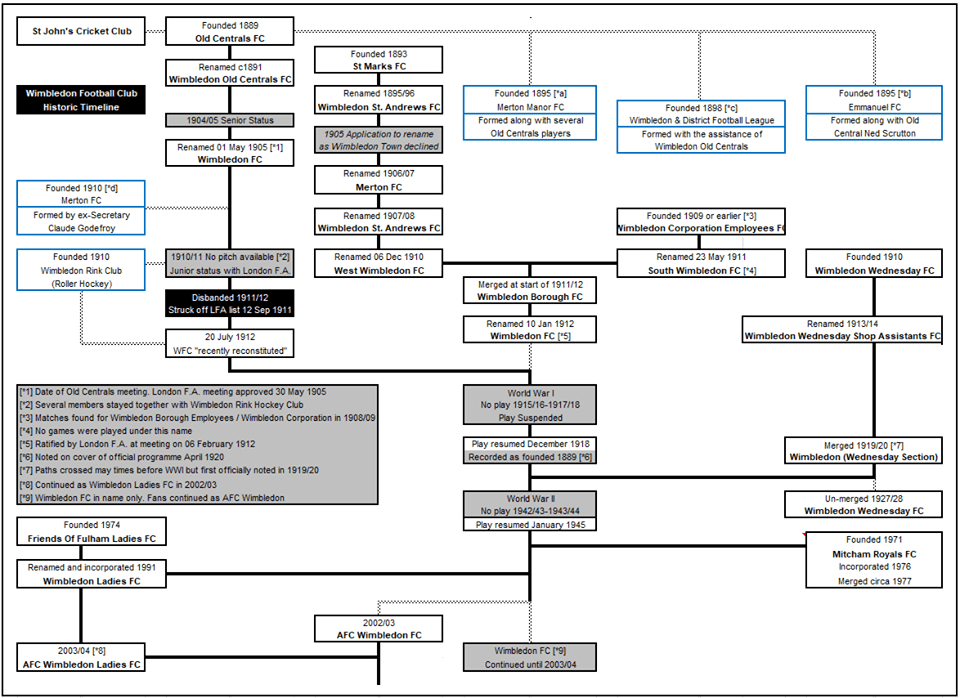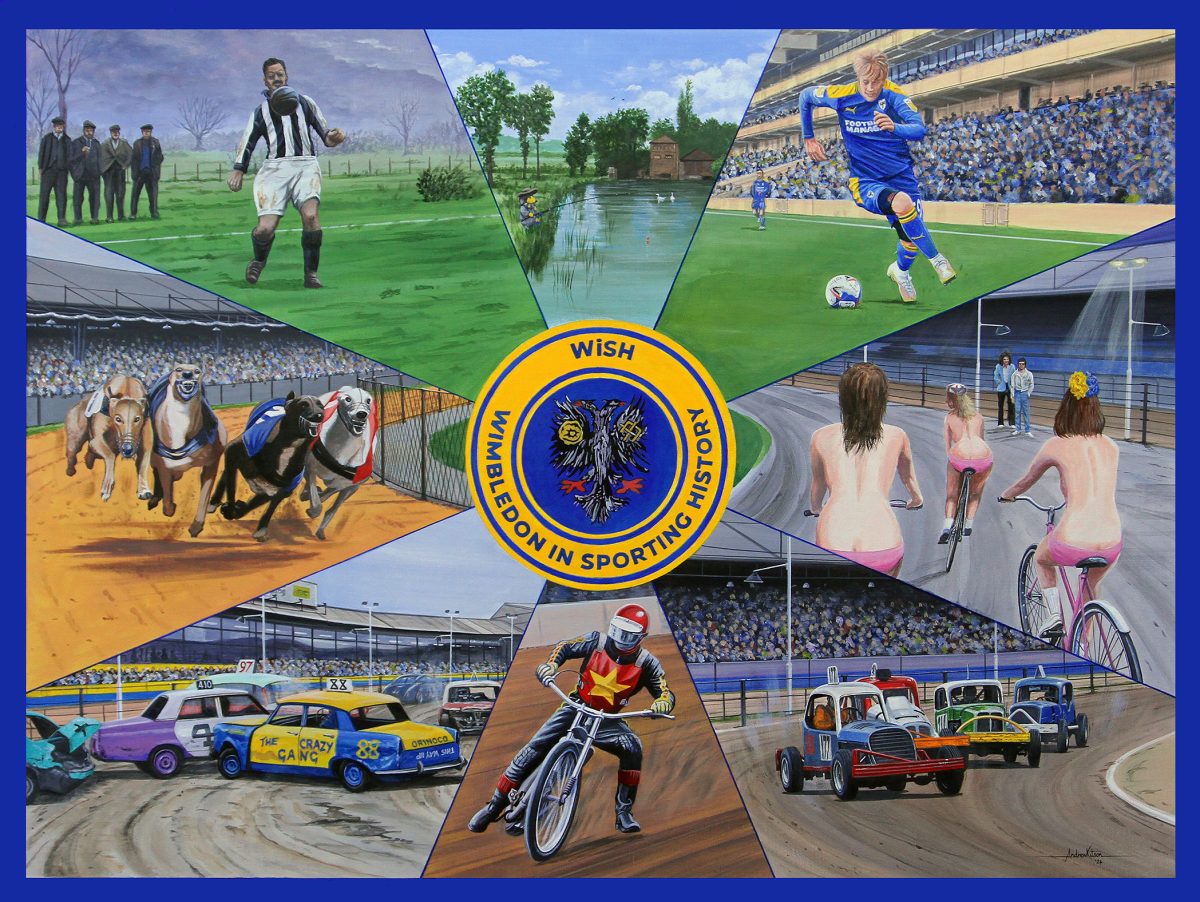The Journey of Wimbledon Football Club

Founded in 1889, Wimbledon Old Centrals Football Club’s first ground was on Wimbledon Common. The players were former pupils of the Old Central School in Camp Road, which is where the club originated from. The club grew from strength to strength winning numerous victories in the Clapham League (1896 and 1901) and was awarded senior status in 1905 by the London Football Association; it then changed its name to Wimbledon Football Club to mirror its wider appeal. Predominantly for financial reasons the club changed ground eight times over 22 years, at one point relocating to New Malden in what we know today as the Royal London Borough of Kingston. Financial uncertainty meant the club was disbanded in 1911. However, a new club was set up which reverted to the old name of Wimbledon Old Centrals FC and played at Coppermill Lane, off Plough Lane.
The club then entered complex negotiations with Merton Council. In 1912 the Council provided the leasehold on disused swampland at the corner of Haydons Road to four merging football clubs, Wimbledon Wednesday, Wimbledon St Andrews, Wimbledon Borough and Wimbledon Old Centrals; they became Wimbledon Football Club (reverting to the original name, given in 1905 to the football club representing the area). Plough Lane became Wimbledon Football Club’s (Wimbledon FC) spiritual home and the club’s permanent home until 1991. Wimbledon FC reached the FA Amateur Cup Final in both the 1935 and 1947 seasons. In 1963 Wimbledon FC won football’s highest amateur honour, the FA Amateur Cup, at Wembley, in 1963. Eddie Reynolds scored four headed goals in the 42 win over Sutton United (a feat never matched in any Wembley Cup final since). With Wimbledon FC achieving such great success, the decision was made to turn professional for the 1965 season.
The team continued its success finishing as runners-up in the Southern League in its first professional season. During its appearance in the FA Cup in 1975, Wimbledon FC became nationally famous for becoming the first nonleague team in that century to beat a First Division side away from home, defeating Burnley at Turf Moor. The club then went onto play the First Division league champions Leeds United, forcing a replay with a 0-0 draw, but went onto lose the replay at Selhurst Park (Plough Lane was deemed unusable for the match). After winning the Southern League three times consecutively from 1974 to1977, Wimbledon FC was elected to the Football League for the 1978 season. Between 1978 and 1985, Wimbledon FC climbed the Football League from Fourth Division up to the top league in English football. Remarkably this was achieved in just nine years from when the club first joined the Football League – an unprecedented feat. In 1986 Wimbledon FC sat top of the league ahead of Manchester United, Arsenal, Everton and champions Liverpool.
The club’s greatest moment and one that took the football world by surprise came in 1988 when the team won the FA Cup Final against Liverpool on 14 May at Wembley. This victory famously made Wimbledon FC only the second football team in history (and the only team in the twentieth century) to have won both the FA Cup and the FA Amateur Cup. The 1988 FA Cup Final is widely viewed as the last giantkilling act (where a small team beats a big team) and the last showcase final to be played in front of almost 100,000 people. Dave Beasant, who had played for Wimbledon FC through the football leagues and was in his last game for the club, became the first goalkeeper to save a penalty in an FA Cup final preserving Wimbledon FC’s historic 1-0 lead.
Beasant, as team Captain, was handed the FA Cup by Princess Diana. Ironically it was her Great Uncle, Earl Spencer, who wanted to privatise Wimbledon Common. If he had succeeded, the Wimbledon Old Centrals Football Club would not have started playing on Wimbledon Common and Wimbledon FC’s unique history as we know it would not have taken place.


“It was us against everybody else; us against the world even and it was the mentality built into the team by Dave Bassett the manager and we literally would take on the world and most of the time beat them, culminating in the FA Cup final… It was the hottest day of the year. I obviously remember my goal. Dennis Wise had crossed the ball and I’d got my flick to it and it’s gone in past Grobbelaar, the Liverpool goalkeeper. I remember as the game went on I thought one goal would be enough and after Dave saved the penalty I think both sides knew that we were going to win it.”
Lawrie Sanchez, scored the 1988 FA Cup winning goal with Wimbledon FC
Wimbledon FC’s brand of football became known as the team that beat the biggest teams in the land on a modest budget, making household names of players like Vinnie Jones, John Fashanu, Lawrie Sanchez and Dennis Wise. Something was lost when the club moved from Plough Lane to the London Borough of Croydon in 1991 for financial reasons. However, the ‘Wimbledon Spirit’ lived on and the following year, Wimbledon FC was one of 22 opening members in the new Premier League, which would become the most watched league globally. Wimbledon FC continued to beat the big teams and famously knocked out champions Manchester United from the FA Cup in 1997. Towards the end of the 1990s, new Norwegian shareholders brought in their own manager and players and the ‘Wimbledon Spirit’ was broken. The team was relegated in 2000 from the Premier League.
On 28 May 2002 the Football Association (FA) made the unprecedented move of allowing the club to be relocated over 50 miles away in Buckinghamshire. This has been widely highlighted as a mistake; one which will not be allowed to happen again.
AFC Wimbledon And Football Today
The people of Wimbledon were disappointed with the FA’s decision and reinforced the ‘Wimbledon Spirit’ by setting up their own football team. This started a trend in English football. Owned by previous supporters of Wimbledon Football Club and run by volunteers, AFC Wimbledon was founded in May 2002. Turning back to its roots on Wimbledon Common, AFC Wimbledon held player trials on the Common over three days to form the team.
Within nine years AFC Wimbledon has managed to get itself back into the Football League, a feat which took Wimbledon FC 88 years. The goal is to get the club back into the Premier League. Unlike many football clubs AFC Wimbledon does not have a wealthy owner who will fund the acquisition of expensive players. Management need to work prudently in the transfer market and Mark Robinson (who is now Head Coach of the first team) set up an academy which is producing first team players. Goalkeeping hero and Seb Brown and current centre back WIll Nightingale were supporters who would watch AFC Wimbledon from the stands. Moreover, in 2020 AFC Wimbledon built a new stadium in Plough Lane on Copper Mill Lane, a site the club used to play at from 1910 – 1912.



